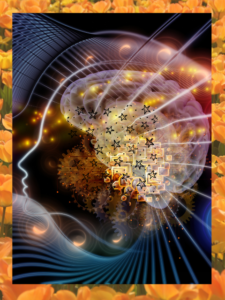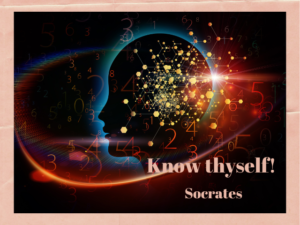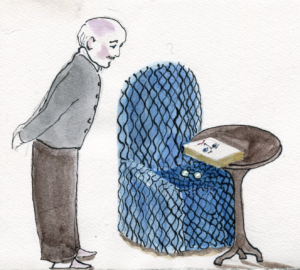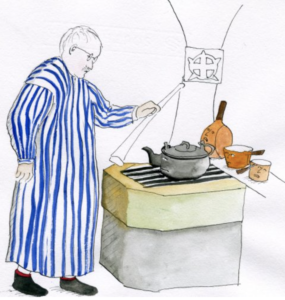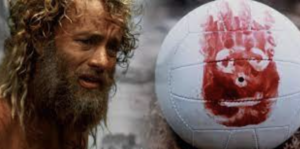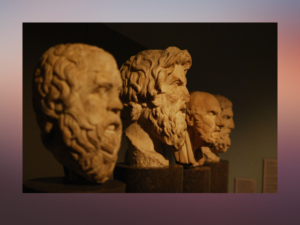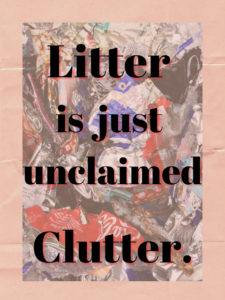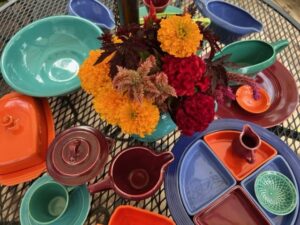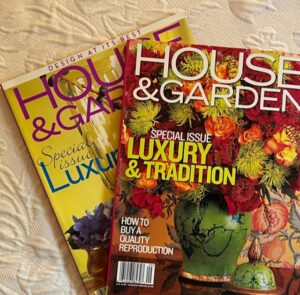Humans need to see beauty everywhere. Not just in museums, paintings, architecture and elegant interiors.Without beauty, what we see depletes us. Good design demands more than our hands and our eyes. Our minds are fully engaged in our creative endeavors. Our thoughts shape our design’s complexities to make them simple and serene. We must be aware of the origin of our design thoughts. How we have arrived at our belief system and how to change it to embrace energizing beauty is addressed in this lesson, Towards a Philosophy of Decorating (in parts A, B, C).
The architect and writer C. Ray Smith once complained about a lack of philosophy in the field of interior design. I believe these words can apply to many areas in need of design.
“Why is there no aesthetic theory of interior design from interior specialists? Why is it all from architects? Interior designers show no signs of having deep, overall philosophies about their work. They have generalized approaches that are governed by strong and individual points of view, and they have strong likes and dislikes. But those are not complete, developed philosophies. Interior designers seem not to develop complete systems of thought or ideology that stretch out to intellectual frontiers of their work; they seem to have no cerebral methodologies that are all pervasive – from overall approach to the minutest detail.”
Designers can protest the idea that no formal philosophical training has crossed their paths and may not see the need to bring in the more complicated ideas of Western philosophy. Why not keep it simple?
What they may not realize is that everybody has a philosophy, either consciously or unconsciously. They are simply paradigms based on some cerebral process in which we perceive reality. It is through these paradigms that we act.
The problem is not in having a philosophy. The problem is not being aware of the one we have. These thoughts, if they remain unexamined, can fuel our decorating activities in unwanted ways.
What is Philosophy?
The Encyclopedia Britannica defines it by first expounding on how difficult it is to define. Throughout time, philosophy has had many different meanings. Some are:
- The search for wisdom and knowledge (epistemology).
- The study of being (ontology) and the study of becoming (process philosophy).
- The quest for an understanding of man’s social and moral responsibilities (ethics).
- The study of man’s mind, the origin of ideas and consciousness
- An attempt to understand how man communicates and thinks (logic)
- The search for truth, goodness and beauty (aesthetics)
- The study of the universe, God and God’s relationship with man.
- As in theses lessons, it is the search of the reality behind matter (metaphysics).
According to Webster’s Dictionary, philosophy can be defined in the vernacular to mean “the sum of an individual’s ideas and convictions.”
Why Should We Contend With Philosophy
If we have lived in the West, our mindset has been created through the absorption of Western ideas. We have not created our view of reality as individuals but have absorbed our culture’s view. Generally we are unconscious of this absorption; we simply assume that how we view the world is what is true.
But how do we know if our perception of reality is pure. Can we get out of our mind and look at ourselves?
One way to begin to know our minds is to become more aware of the thinking traditions which have led to our perceptions of reality and question that thinking. Foremost of those traditions is the large body of knowledge called Western Philosophy.
To develop a complete philosophy of decorating, one must first examine one’s own view of reality. Often these internalized ideas are someone else’s, several kinds in contradiction, some other group or some past inherited culture that does not serve us in the present day. Socrates’ motto, “Know thyself,” is a good place to start. Looking at one’s family beliefs, environmental influences and education is important. Most significant of all one’s collective cultural history is essential.
Make no mistake about it. We are the products of our culture’s thinking and we must see it and find our way within its maze. As Richard Tarnas describes it in The Passion of the Western Mind, “the long battle of ideas called ‘the Western tradition’ has been a stirring adventure whose sum and consequence we all know within ourselves.”
Western Philosophy and Design
It can seem a complicated place, this one of Western Philosophy. But often within its complexities and its cyclical nature, one can find the simple threads of ideas. Within the search of harmonious decorating through
- creating subliminal geometric patterns and
- correcting our relationship with objects
as explained in The Preface, four ideas explored in Western Philosophy come to mind. They are:
- The separation of spirit and matter
- The definition of beauty through the search for truth
- The negative and positive aspects of the Western mind
The Separation of Spirit and Matter in the West
Recently a friend who occasionally does housekeeping for me broke a statue of a glass hummingbird. She was very upset and wanted to pay for a replacement. I refused because I did not believe her to be at fault. In an attempt to calm her in a text, I said among other things, “I believe things have a say when they break.” I was admitting in my text that I believe in animism, that there is no separation between spirit and matter and that all matter is alive.
I don’t believe my objects have brains or consciousness. I just know that they, like humans and all fauna, flora and minerals came out of the same sea of primordial ooze that led to life as we know it and have some connection to becoming more alive, interactive and infused with spirit.
This thinking is not accepted in the West because our culture is based on the spirit-matter divide, made necessary for the growth of science. Unfortunately, the split was a method but as time went on the method became confused with reality. In so doing our philosophy has taken the spirit out of matter. Had the spirit-matter split been used only as a method, then we would not have as many problems in the West. Because of that it has sent many in the West, who are not aware of how they think on an endless search for spirit.
Secret Animism
Despite the West’s crushing attitude against animism, there are many who maintain animistic beliefs. Most are hidden. Carl Jung was quite open about his belief that his objects were alive and had their own agendas for being. He addressed his problems with rebellious possessions like documents “hiding themselves,” or “a pair of glasses seeking out a chair of a concealing pattern.”
He noted in Memories, Dreams and Reflections that one time he stayed in bed missing breakfast because of a serious illness. One morning he woke up hearing a loud clanging. He knew immediately that his favorite pot was acting out. So he went to the kitchen and said to the pot, “I’ll be back with you soon and we’ll make some good things together.” He mentioned that after his conversation with the pot, the noises stopped.
I mention Jung because his name commands respect and causes us to pause at his anti-Western Philosophy stance. There are, however, many, animists practicing today, consciously and a lot more subconsciously. Some may deny it since it is not acceptable but their actions speak to an inner belief. We name our cars, we have a hard time getting rid of things because we feel some soulfulness in our objects and sometimes find ourselves talking to our things. Open or hidden animists all have all found themselves cursing at their computers. We still have bonds with our teddy bears, cartoon characters and other objects. We easily latch onto an item which culturally has brought joy and comfort.
Think of the soccer ball painted with a face by the Tom Hank’s character in the movie, Cast Away. Stuck on the island for four years after a plane crash, living off the planes’s debris, he finds a Wilson volleyball and paints a face on it, names it Wilson it and talks to it on a daily basis. It becomes his companion. It becomes alive.
We cried when, unattended, Wilson floats out to sea. This piece of plastic emitted so much of a life force that sporting companies and Amazon sell close to $25,000 per year. The original movie prop sold for $308,000.
The Life of Animism
Valerie Andrews and Ann Arnold in “The Secret Lives of Our Possessions“ note, “In older cultures, people believed that ordinary objects were alive with energy and meaning. When we treat our possessions with respect and kindness, they become not just helpmates but talismans. In indigenous societies, an amulet or bowl can possess a kind of holiness or grace, transferring these powers to its owner, while Shinto Buddhists are apt to thank a plate or pair of shoes for their daily service. ”
“For centuries of human development this notion – called panpsychism – was the dominant belief – at least until Descartes separated thought (res cogitans) from matter (res extensa) and the rationalists put man at the top of the hierarchy, scoffing at the notion that animals and objects might have souls.”
Western Philosophy and the Spirit- Matter Divide
I don’t believe it was solely Descartes who was responsible for the spirit matter-split. He just cemented the ongoing philosophical debate that started in its beginning.
Greek philosophy began when the culture slowly moved away from a belief in the gods to a quest for knowledge and a desire to form order out of chaos. It questioned how the world works and what it was made of. Throughout its history, the question whether matter was alive spotted the development of Greek thinking.
When Greek philosophy began with the Milesian school in the 6th century B.C., science and religion were melded and there was no distinction made between spirit and matter. In fact the Milesians had no word for matter since they believed everything was alive. Thales of Miletus, the father of Greek philosophy, said that “the gods were in everything” and his successor Anaximander believed that the universe was animated by “pneuma” a spiritual breath.
Heraclitus also believed that the world was alive and ever changing and that what appeared as opposites was melded through the transcendence of a unifying principle which he called the “Logos.”
Parmenides the founder of the Eleatic school challenged the doctrine of Heraclitus stating that apparent change was a trick of the senses. He considered change, destruction, and motion as illusions. Although he believed a Divine Principle existed above the universe which controlled the world, the universe itself was made of dead matter.
In an attempt to reconcile the philosophy of Heraclitus who said that all was in flux with the philosophy of Parmenides which said that change was impossible the Greek philosophers of the fifth century BC led the way for the philosophy of the atomists, Leucippus and Democritus.
The word atom comes from the Greek word for uncuttable. In this new philosophy matter was seen as dead irreducible objects moving around in a void. It was the atoms’ random movement in the void which seemed to create new substance. The cause of the motion was not addressed but was often connected to outside forces. Thus the division of spirit and matter which has shaped Western thought became more entrenched.
So thinkers bounced around with their ideas of matter and spirit until we moved into the modern times.
***
Throughout the Middle Ages, in a Church developed culture, little attention was given to the material world. The resurgence of Aristotle gave the basis for Church law and great minds like Augustin and Thomas Aquinas enriched the institution.
For the most part the Church was focused on the development of the spirit. Matter was seen as an impediment to the desired salvation of man’s soul. This lack of interest in matter was ingrained in Western thinking for over a 1000 years.
Parallel to the culture of the Church, scientific inquiry slowly began. By the Renaissance, this quest exploded and man began to look at the natural world with a new awe. The Renaissance with its eye to inquiry and observational methods of nature led to the Enlightenment and Scientific Revolution. As the scientific inquiry grew, attention was pulled away from spirit and centered only on matter.
The Scientific Method
At some point, science, in its attempts to find truth had to codify its observational methods. Thus was born the leanings toward a scientific method. Many philosophical advances were made by Frances Bacon, Thomas Brown, Baruch Spinoza, Pierre Gassendi, Robert Boyle and Thomas Hobbes.
The term, “the scientific method” came into popular use in the 19th century but it was emerging as a practice since Aristotle and others before him. It demanded observation by the senses and a pure ground for observation. This meant that the observation of the material object could not be affected by the observer’s thoughts or prejudices. Its results could not be predicted by the Church or the Kings. In essence, it had to be exempt of spirit to be properly observed.
Some of the leading scientist were also alchemists and worked on astrology as well as astronomy, alchemy as well as chemistry. Three of these scientists who worked in both worlds, choose to purify scientific observation. So under the tutelage of Charles II, Johannes Kepler, Issac Newton and Elias Ashmole formed the Royal Society to study the natural sciences. The society banned all discussion of religion at its meetings. The founders, as alchemists, believed in a spirit infused material world. They realized, however, that in the religious conflicts of Europe that scientific potential could not be reached if it were forced to satisfy the criteria of a spiritual truth. So they created the organization against their own beliefs. Descartes’ work, only a decade earlier, created the thinking that cemented this new perspective.
The Best and the Worst of Descartes
Now it is fashionable today for new-agers to do a little Descartes bashing. There is no doubt that spirit/matter dualism has contributed to some of the ills of present day society in the West. For one, we have totally divorced ourselves from nature as the science resulting from the spirit/matter split has attempted to control nature to its own ends. Destruction and pollution have resulted. For another, we have put ourselves at a disadvantage by divorcing the mind from the body in medical research. It has only been recently that we have begun to look at the wholeness of the body to cure disease.
Yet the dual thinking of the West has produced some very great advances. The antibiotic which saves our life, the computer age which has brings us the internet and the global village, electricity and air travel are all part of the comforts which we enjoy today because of the matter-spirit split.
There have been positive and negative results from separating spirit and matter. It would be beneficial to be grateful for the gifts of Western science while trying to to find a way to heal the split.
How the Spirit Matter Split affects Aesthetics
There are a lot of problems if we keep spirit and matter apart in decorating in the West.
It is my contention that addictive shopping and excessive materialism are really the search for the spirit. It is the theme of these lessons that harmonious design is based on subliminal geometric scaffoldings based on nature and positive relationship with the objects we own.
Neither is easy if we have too much stuff. It is not impossible to design geometrically with a lot of objects, it is just more difficult. Having positive relationships with our objects gets watered down too if we crowd ourselves with things that have no meaning for us.
Too many things kills good design. Taking the spirit out of matter causes one to become obsessive about finding it and in the search, we buy more. I know this because I see it in myself.
According to Jennifer Howard, author of Clutter: An Untidy History, “Americans learn from cradle to grave that stuff = happiness, and when the things we buy do not make us happy, or when the buzz of the last purchase wears off, we buy more. And more, and more—whether it’s fast fashion or cars or pet supplies or smartphones. The consumer engine burns through precious personal and environmental resources to feed desires that can never fully be satisfied. That’s the point. If we felt we’d reached the point of material satiation, we’d stop shopping, and the engine would shut down.”
When she refers to the “buzz of the last purchase” I believe that buzz refers to the connection to spirit. The reason it wears off is that, because of Western thinking, we don’t have a way to hold that spirit with the material object we just bought.
I believe if we ever healed the spirit -matter divide, we wouldn’t buy so much and need all these clutter books and programs to get rid of the excess.
Our “wealth” of too many things causes us to go through occasional purges, adding to burgeoning landfills. Some of the discarded stuff does not make it to the dump but ends up in empty lots, the side of the road and on the streets. Clutter now becomes litter and in so many ways hurts the Earth.
Healing the spirit-matter divide is something I have to work on too-the more I do the more I can let go of the things that own me.
The Spirit in the Dish
I love stuff. I collect, shop in antique stores and always have my eye peeled to the curb of Park Avenue on dump days .
I am passionate about dishes, pottery and vases. I have many beautiful types of all these objects. I need no more. Yet when I see another set of beautiful dishes in a store or a friends house, I have to fight the temptation to buy them. One only needs one set of dishes – perhaps two at most. Why, I asked myself did I have the urge to have more. It is mostly, not always, in our collections that we might find our need to attach to spirit.
At some point I realized that I was looking for the feelings that I experienced when I bought my first set of dishes. The joy was gone. I thought buying more would bring back those feelings for a while at least. I came to realize that those feeling were gone because on some level I, a product of Western thought, separated the spirit from the object.
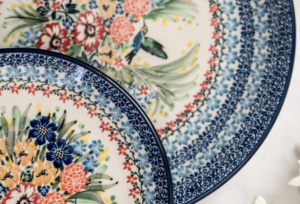
I found a cure once I realized that it is the spirit within the object and not the actual object which I craved. Whenever I find myself wanting another set of dishes or piece of pottery, I take one my dishes and start to meditate on the spirit in its beauty. I remember what I felt like when I bought them. I try to reconnect to those feelings and when I do, the urge to buy more dissipates.
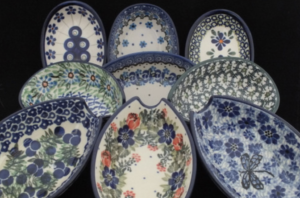
Fighting the Urge to Buy More
This kind of thinking helps me for the most part. If I see a beautiful piece of furniture which I crave but don’t need, I focus on what I have and try to focus on the spirit engendered through their beauty. Now please understand, I have nothing against buying or replacing items to bring out a better design. I am not against the material. I’m against having more than we need since the more we have, the more difficult it is to maintain good design.
I am generally balanced with what I own and how I absorb all in good design. When I start to crave that which I don’t need my spirit -thinking works well. Sometimes, however, things get out of control and no amount of proper thinking helps. Within that frenzy, there was another lesson to learn. It came to me when I was assailed by the pages of the special issue of House and Garden: Luxury and Tradition (2003.) It put me out of control.
All in one issue, I was affected by countless objects that had me salivating with desire. I pined over Donghia fabrics which bespoke understated luxury, an industrial stove with an exposed brick wall, ancient stone with a patina that speaks history from the Yangtze river Valley being imported to US gardens, Morris and Company fabrics advertising the best designs of the Arts and Crafts movement in the fabrics and wallpapers of William Morris. The magazine featured the designs of the Bauhaus painter Guntha Stolzl in a rug and newly designed furniture in the Moderne tradition inspired by Ruhlmann. The designs of Eileen Gray, Richard Neutra and Frank Lloyd Wright were shown in houses of their design which were lovingly restored by their owners. A house in Connecticut was redone to resemble an English manor house. There was an article on bonsais which I wish I could grow. And of course to really finish me off was the Bold Look of Kohler.
All this in one issue. I didn’t want everything but I wanted a lot.
Finding Another Cure
I madly went around focusing on the spirit of my oak desk and the fabric of my duvet cover and always of course I was trying to rediscover my dishes. Nothing was working. I was still left with an incredible sense of desire and an inherent sense of loss.
At some point I realized the nature of my cravings. It wasn’t the separation of spirit and matter which affected me. I was looking for something new. It was not the object that I craved, it was some sort of energy in the boldness of this new design and in the beauty of those timeless classics. In the newness of design and in the creativity of current artists and designers as well as in the retro objects of designers of the past is the spirit of creation. It was that spirit of creation which I craved in the artistry of what I saw. Just realizing this calmed me down.
Protecting the Earth
Now my scientist friend flips when I try to tell him that matter is alive. He can’t conceive of a paper clip as a life force.
Well I don’t know if it has consciousness or if it can perceive but I do know that the East which is most of the world, our early Greek philosophers and all indigenous peoples including Native -Americans believe that matter is connected to spirit.
In The Shape of Green, Aesthetics, Ecology and Design, Lance Hosey writes about a sustainable earth and in so doing touches on a spirit infused matter. He doesn’t believe that just creating sustainable products will work to help the Earth. According to Hosey, they must be beautiful. Sustainability must not just be the item’s durability but it also must be its ability to elicit desire. We have all met children dragging along ratty and worn Teddy Bears, even saving them unto adulthood. Those pieces of cloth and cotton felt the bond of the child and lived the life of an objet infused with spirit.
He asked if product designers could inspire such devotion maybe with a sign “Please Open Your Heart.” Hosey writes “If an iPod emulated a Teddy Bear (the iPooh?), churn-dependent Apple might go bankrupt, unless it altered its business model by creating lifelong partners instead of annual customers, by resurrecting the lifetime guarantee to ensure attachment as well as functionality and service.”
The bottom line is that if we felt for our iPhones what we felt for our Teddy Bears and other like items, we might throw less devices into the landfill.
If we could infuse everything with the spirit of our Teddy Bears, we could help the Earth. This could be easily done if we adopted animism.
Revisiting Descartes
Renee Descartes was certainly instrumental in cementing the spirit-matter divide. As I am sitting here with my iPhone in hand trying to imbue a Teddy Bear feeling in it with its scratched up screen and eroding case, I think of Descartes and how different our belief systems. I believe everything has a spirit even though I am not quite feeling it in this iPhone case.
Descartes was not only was a philosopher but took his ideas into his own life. He didn’t believe anything was alive except human beings. Occasionally in some sort of scientific quest, he would cut open dogs when they were alive. He started with his wife’s dog by nailing its legs to the wall and cutting it open. He dismissed its pitiful wails by saying it was some sort of biological response to the movement of flesh.
So I bring up the question, “Do you want to have your current belief system based on someone like Descartes or do you want to look elsewhere.” There are plenty of places to look as you face the philosophical question, “Who am I?”
Descartes and New Science
Today the West still embodies the spirit-matter split. The quantum physicists are backed by different philosophical ideas but common thinking has not caught up with modern times.
Werner Heisenberg, the father of modern physics and himself a scholar of philosophy reflected how philosophy melded with quantum. Of notice is Descartes’ put down of Plato
In relation to Plato, Descartes writes to his friend Regius, “
“They were introduced by philosophers solely to account for the proper action of natural things, of which they were supposed to be the principles and bases. But no natural action at all can be explained by these substantial forms, since the defenders admit that they are occult, and they do not understand them themselves. If they say that some action proceeds from a substantial form, it is as if they said it proceeds from something they do not understand, which explains nothing.” “Letter to Regius,” January 1642, in Ouevres de Descartes.
It is an irony that Heisenberg, one of the fathers of quantum physics, saw the philosophy backing this new science as leading away from the empiricism of Aristotle and Descartes. The concept of the observer as a factor in manifestation of matter from the abstract world of possibilities into the realm of actualities is a Platonic ideal. In response to the philosophers of classical empiricists, Heisenberg wrote in The New York Times Book Review , “I think that modern physics has definitely decided in favor of Plato. In fact the smallest units of matter are not physical objects in the ordinary sense; they are forms, ideas which can be expressed unambiguously only in mathematical language.”
Quantum physics is difficult to understand so the anti-Descartes approach has not sunk in. One day it will and Westerners with not see spirit split from matter. Until then, use your readings, and insights and mostly your self-questioning, and then act accordingly.
This lesson will continue in two more parts: Part B, The Definition of Beauty Through the Search for Truth and Part C, The Negative and Positive Aspects of the Western Mind
There are two parts to this website, The Lessons, which are more difficult in concept and the blogs, which are lighter in nature.
The following are blogs with the same theme as Lesson IX that you might enjoy:
Collecting Objects – The Purpose of Things
The Spirit of a House and the Angle of the Meander
Magazine Clutter….What Should I do with All My “Martha’s”
Please note that my website allows you to leave comments at the end of the blogs but not at the end of each lesson. If you have a comment or question about a lesson, you may email me at ruta@rutas-rules.com.
